 Multiple Choice Questions
Multiple Choice QuestionsA mouse was primed with trinitrophenol-lipopolysaccharide (TNP-LPS) where another mouse was primed with TNP-Keyhole limper hemocyanin (TNP, KLH). After three weeks, these mice were sacrificed and splenic cells were functionated to B cells and T cells. B cells from TNP-LPS primed mice were co-cultured with T cells from TNP-LPS or TNP-KLH-primed mice. Similarly, B cells from TNP-KLH primed mice were co-cultured with the T cells from TNP-LPS or TNP-KLH-primed mice. So, we have four co-cultures:
(A) BTNP-LPS x TTNP-LPS
(B) BTNP-LPS x TTNP-KLH
(C) BTNP-KLH x TTNP-LPS
(D) BTNP-KLH x TTNP-KLH
Among these co-cultures, where do you expect the highest IgG production?
(A)
(B)
(C)
(D)
Three E.coli mutants are isolated which requires compound ‘A’ for their growth. the compounds B, C, and D are known to be involved in the biosynthetic pathway to A. in order to determine the pathway, the mutants were grown in a medium supplemented with ONE OF THE COMPOUNDs A TO D. the results obtained are summarized below.
| Mutant |
Medium supplemented with compound A |
Medium supplemented with compound B |
Medium supplemented with compound C |
Medium supplemented with compound D |
| 1 | + | 0 | 0 | 0 |
| 2 | + | 0 | 0 | + |
| 3 | + | 0 | + | + |
'+' indicates growth; '0' indicates a lack of growth.
Which of the following represents the biosynthetic pathway of A?
B → C → D → A
C → D → B → A
B → D → C → A
A → C → D → B
The auxotrophic strains of E.coli : A (met - bio - thr + leu + thi+) and B (met + bio + th- leu – thi) were incubated together for 18 hours in a liquid complete medium and then ~ 108 cells were plated on a minimal medium. Prototrophs were observed at a frequency of 1 x 10-7 cells. This may have happened by a process of genetic recombination between the two strains or by mutation of the strains. Which of the following control experiments would help rule out the possibility of mutation?
Plating strains A and B directly on minimal medium.
Growing the mixture of strains A and B for 18 hours and then plating on complete medium.
Growing strains A and B individually in a liquid complete medium for 18 hours and then plating them on a minimal medium.
Growing the obtained prototrohs in a liquid complete medium for 18 hours and then plating them on a minimal medium.
Why the lysogenic cycle is more beneficial to a virus than the lytic cycle under certain circumstances?
The lysogenic cycle prevents the local extinction of the host while still retaining its infection potential.
By integrating with the bacterial chromosome, the genetic instructions for the virus become refreshed after one or more replication events during binary fission.
Lysogenic infection cycles do not harm their host cells, so they can produce virus particles indefinitely.
Lysogeny causes more mutation to occur in the virus, creating more variants upon which natural selection can operate.
Biologists randomly sampled about 3000 insects from a newly found island. The distribution of their abundance in the sample was as in the figure given below.
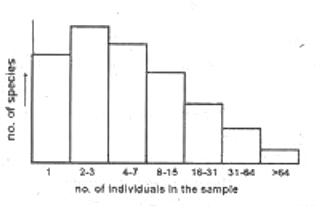
Which of the following can be correctly inferred from the graph?
Many species have only one individual each on the island.
The bar on the extreme right represents a large number of species with very few individuals.
The summation of the heights of all columns will be exactly equal to the total number of species present on the island.
All species from the island may not be represented in the sample.
In a Radio-immunoassay (RIA) for glucocorticoid hormone, radioactive glucocorticoid (tritiated) is added to the RIA cocktail. When the amount of bound hormone was measured no counts were observed. The following explanation (s) were proposed:
A. The radioactive hormone was insufficient.
B. The radioactive tag to the hormone completely dissociated during storage.
C. The antibody was not added to the cocktail.
D. The specific activity of the tritium was low.
Choose the correct option (s):
(A) only
(C) only
(B) and (C)
(A) and (D)
Which of the following curves correctly represents the process of antibiotics production by Streptomyces species.
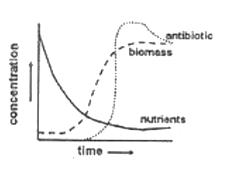
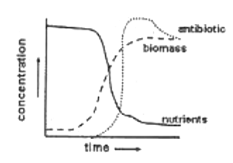
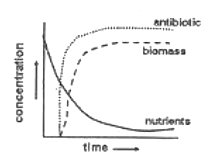
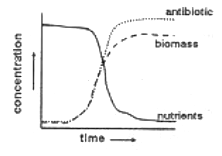
Ten different mouse strains were primed with whole Keyhole limpet hemocyanin (KLH). KLH was broken into ten peptides for in vivo stimulation. The splenocytes from ten different primed mouse strains were restimulated with each of these ten peptides and the responsiveness to these peptides. When the peptide 3 responder was mated with peptide 4 responder, the splenocytes of F1 offspring responded to both the peptides. Which of the following is most appropriate?
Mouse strains responding to peptide 3 or peptide 4 have different MHC haplotypes.
Mouse strains responding to peptide 3 or peptide 4 have either of these T cell receptors.
Mouse strains responding to peptide 3 or peptide 4 cannot process KLH.
Mouse strains responding to peptide 3 or peptide 4 did not express MHC class-I molecule.
If one wishes to design a microarray chip for whole-genome expression analysis of a eukaryotic system, which region of the gene should be preferred for selection of unique target sequences?
any region of the coding DNA sequence (CD)
3' region of the CDS and 3' untranslated region (UTR)
5' region of the CDS and 5' UTR
1st intron only
For 5' end labeling of DNA, the following reactions are carried out sequentially as indicated.
5'-dephosphorylated DNA + [γ32P] dATP + T4-polynucelotide kinase (T4PNK) and incubated for 2 hours → ammonium acetate →tris-EDTA → ethanol
If trace amount of NH4+ is present in the initial DNA mix, which of the following statements would most likely be true?
NH4+ ion activates T4PNK, thereby increasing the labeling efficiency.
NH4+ ion inhibits T4PNK, therefore should not be present in the DNA mix.
NH4+ ion does not have any effect on T4PNK.
NH4+ ion dephosphorylates DNA, thereby increasing the labeling efficiency.
B.
NH4+ ion inhibits T4PNK, therefore should not be present in the DNA mix.
Among the given statements, statement 4 is the correct one.
